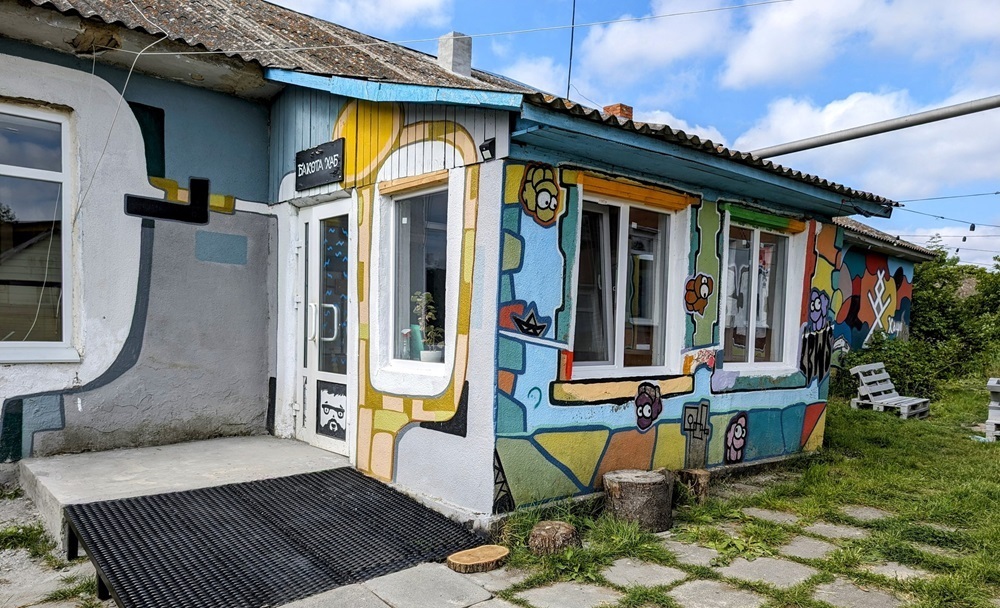Strengthening the Local Economy. What Are Creative Hubs and How Do They Breathe Life into Communities
Today, the economic success of a community is based not only on the quantity of goods produced, but also on its ability to generate new ideas and develop creative industries.
Kateryna Kravchuk*, a sustainable development researcher, spoke about the future of the creative economy, how to create a creative hub in a community, and why it is needed, during the forum “Comprehensive Spatial Planning of Communities - the Foundation of Ukraine's Sustainable Development.” The event was held with the support of the USAID HOVERLA Activity.
Below are the highlights from Kateryna Kravchuk's speech on creative hubs and the creative economy.
The economy of the future
The creative economy is centered on human creativity and innovation. Instead of producing material goods, as in industry, the creative economy focuses on intangible resources, such as intellectual property, cultural products, and new ideas. It covers all types of activities where the main resources are creativity, talent and knowledge: from folk crafts and art to media and information technology.
The essence of the creative economy is that ideas and creative products can not only inspire and delight people, but also attract investment and generate profit. Small and microbusinesses constitute 90 percent of the creative economy, collectively creating many jobs. The creative economy accounts for at least 4 percent of Ukraine's gross domestic product, which demonstrates its important contribution to economic development. Such products are also a significant source of exports. This was especially noticeable during the war, when many factories were forced to shut down, but the creative economy continued to support the country.
The creative economy is called the economy of the future because in this sector robots are much less likely to replace human jobs in this sector. There's a simple explanation for this: artificial intelligence works with what humanity already knows, while creativity is always about something new and, therefore, about the future.

Kateryna Kravchuk, sustainable development researcher
Spaces where change is born
A creative hub is the heart of the development of the creative economy in a community. It is a space that brings together creative people, where they can not only work on their own projects but also participate in joint initiatives and grow professionally in culture and creative industries. Creative hubs can also be virtual, but mostly people need to meet in person, so these are primarily physical spaces.
Creative hubs can take a variety of forms: coworking spaces, makerspaces (public workshops with shared equipment), spaces for artistic or educational events, art residencies, studios for artists, or offices for entrepreneurs. They all have one goal in common: to create positive changes in business, culture, and society.
Creative hubs are usually found in big cities because there are universities there, and professions in the creative industries are intellectually demanding. However, such spaces are equally important for small towns and villages: they are places to gather, exchange ideas, and find like-minded people. There are already successful examples in Ukraine, such as Bakota Hub (Horayivka village, Khmelnytskyi Oblast), which hosts art residencies, and the Creative Rural Hub makerspace (Verkhnii Verbizh village, Ivano-Frankivsk Oblast), where visitors can use 3D printers, laser machines, and other equipment to embody their ideas. So, no matter how many people live in a town or village, it makes sense to create creative hubs, because these are spaces where an active creative community is formed that develops the community.

Source: Bakota Hub Facebook
How to create a creative hub in your community?
A creative hub is a laboratory where ideas for community development are born. Creative hubs stimulate local entrepreneurship, revitalize cultural life, and can even become a community's calling card, attracting tourists and new citizens.
Any creative hub starts with people who share common interests, strive for development and are ready to create something new.
Before you start arranging the space, you need to gather like-minded people around you, identify their needs and expectations.
Creative hubs are rarely built from scratch; they are often created in existing community buildings such as old factories, cultural centers, or abandoned buildings. This approach not only saves resources but also gives space a unique character.
Each community has its own highlights, so a creative hub should be adapted to its specifics. It is important to answer the following questions: What kind of people live in the community? What are they interested in? What spaces do they like to visit? What forms of creativity are developed here? The chosen format of a creative hub and the direction of its activities will always depend on the community context. It is necessary to understand the local traditions and interests of the residents so that the creative hub becomes not just a workspace, but a real center of local culture, exchange of ideas, and a drive for economic development.
Kateryna Kravchuk is a co-founder of the creative agency Lanka.pro, a facilitator, economist, and designer of development products. She researches the role of cultural and creative industries in sustainable development. Co-founder of the Ukrainian Network of Internal Development Goals.

19 December 2025
Locally-led Recovery Planning: How Polaris Strategic Sessions Work
Locally-led Recovery Planning: How Polaris...
The Polaris Programme continues to provide systematic support to hromadas under its Locally-led Recovery sphere. In...
19 December 2025
Boryslav City Council approves new Community Charter
Boryslav City Council approves new Community...
Today, on 18 December, the Boryslav City Council made a historic decision by approving the Charter of the Boryslav...
19 December 2025
Public Finance for Children (PF4C) Ukraine's State Budget 2026 Overview
Public Finance for Children (PF4C) Ukraine's...
UNICEF Ukraine has prepared a brief overview of Ukraine’s State Budget for 2026, with a focus on financing for social...
19 December 2025
Питання релокації пожежно-рятувальних...
“Велика війна” зумовлює не завжди очевидні виклики для територіальних громад. Хоча законодавчі органи активно...
